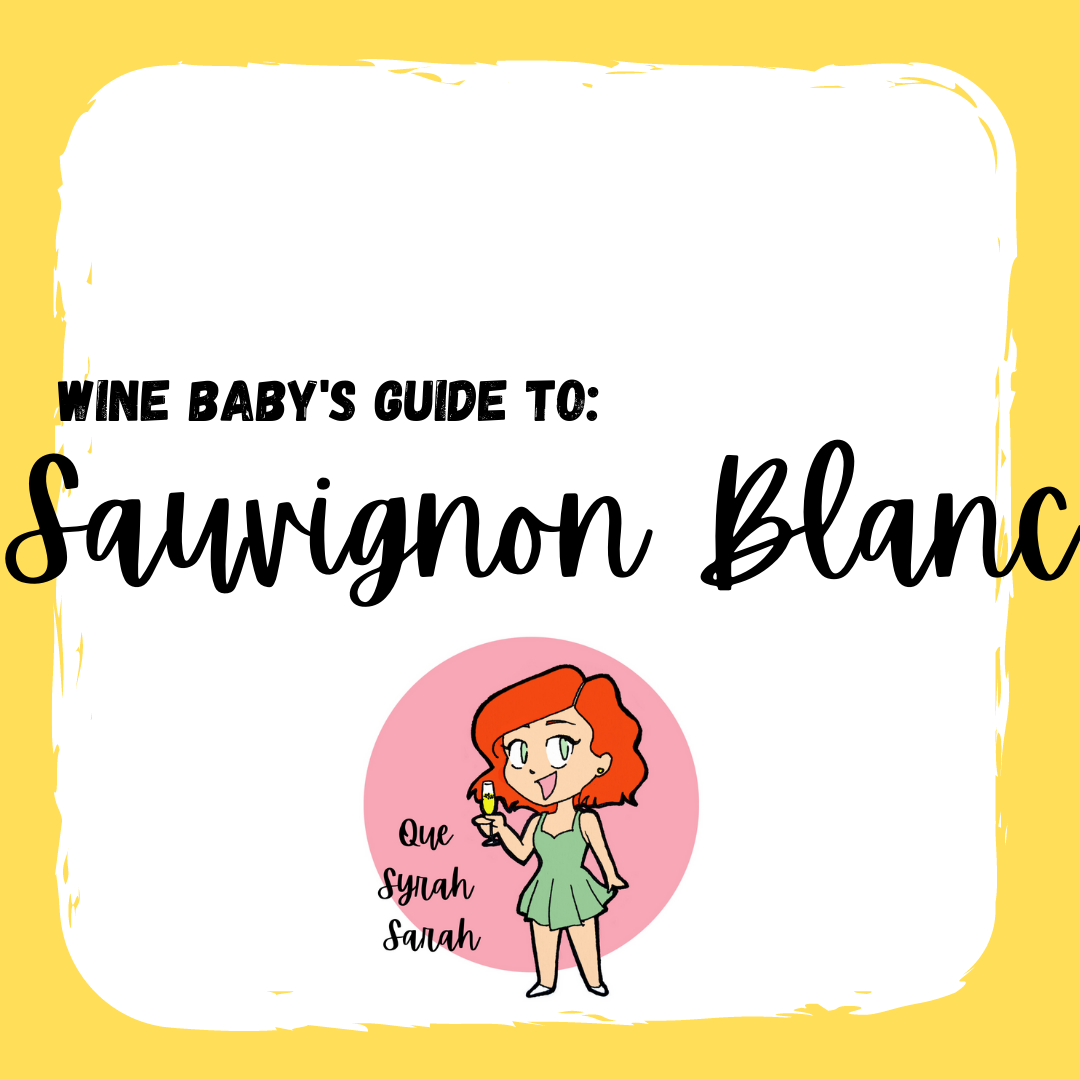
Wine Baby’s Guide to: Sauvignon Blanc
Ahh, Sauvignon Blanc. What a delightful wine.
I have to admit that when I first started drinking wine, I wasn’t a fan. I couldn’t quite put my finger on it then, but there was something about it that turned me off. I didn’t *get it*.
But that all changed when I started learning more about it. I was able to learn an appreciation for it, and now I’m in love!
This is why I really enjoy learning about wine and sharing it with you – whole new horizons open up!
So even if you don’t love Sauvignon Blanc, grab a glass and taste along with me. Maybe you’ll acquire a taste for it, just like me.
TASTING SAUVIGNON BLANC
Ok, got your glass in hand? Let’s jump in to tasting this “wild” wine.
Side note: The name “Sauvignon Blanc” comes from the French word “sauvage” meaning “wild”. This is because the vines grow so vigorously that quite a bit of canopy management is needed in order to produce high quality grapes.
Colour
Sauvignon Blanc produces a light white wine. In the glass it typically is a lemon-y yellow, sometimes I almost see hints of green. And in intensity, it can range from medium to incredibly pale.
Nose
The aromas of Sauvignon Blanc are markedly intense. It is most recognizable by it’s green, or herbaceous notes. Think green bell pepper, grass, or asparagus.
Some even smell like cat pee! No wonder I was iffy on it to start…
But it also hosts a range of other fruit smells that help to round it out. In particularly zesty bottles you’ll find notes of green fruit and citrus, like green apples, gooseberry, lemon, lime and grapefruit.
Some styles sit more on the tropical or orchard fruit side, with passion fruit, melons, and peaches.
Sometimes delicate floral notes will dance across your palate.
And sometimes it takes a more mineral twist, with hints of smoke, gunflint, stone, chalk, or even spent matches.
Different styles of Sauvignon Blanc tend to lend themselves to different ends of the aroma spectrum depending on where they are from.
For example, New Zealand Sauv Blancs tend to be more “green”, and French Sauv Blancs carry more mineral notes. It’s a good idea to taste a few Sauvingnon Blancs from each region to get to know which style you prefer.
Palate
When you take a sip, the first thing your tongue will likely notice is the high acidity. It is a defining characteristic of Sauvignon Blanc. It’s often described as “zippy” or “zesty” or “fresh”. Those terms are all referring to the acidity.
As a white wine, you won’t find any real sensation of tannins in here. And the alcohol content sits around medium.
While Sauvignon Blanc is most commonly made dry or off dry, there are some sweet options out there.
All of these components combine to give you a light to medium bodied mouth feel.

PAIRING SAUVIGNON BLANC
Since learning to love Sauvignon Blanc, it’s become my go-to pairing for seafood dishes. There’s just something about it that screams “oysters” to me (even though I’ve never had an oyster in my life!).
It also has enough flavour to hold up against other light meats with herb-driven sauces. Some tangy Asian food would pair quite well.
SHOPPING FOR SAUVIGNON BLANC
I’ve already mentioned the top two regions to check out when heading to your local wine shop: France and New Zealand. The key to a good growing location is a cool to moderate climate, so there are lots of other great regions producing Sauvignon Blanc, but you’ll want to know these two because many other regions try to mimic one or the other in style.
Let’s start with France, as it is the birthplace of Sauvignon Blanc.
If you want to find a great quality Sauvignon Blanc, you’ll want to find one coming from the Loire Valley. In particular, Sancerre and Pouilly-Fumé are the top two notable appellations. Because Sauvignon Blanc is the only white these regions produce, the wines are named after the region, not the grape. Remember that when looking at labels.
If you want something just a touch cheaper, Touraine isalso a great spot to look out for. All of these Loire wines will lean more to Sauvignon Blanc’s dry, mineral side and are quite refined.
Sauvignon Blanc is also commonly grown in the Bordeaux region in France, and is blended with Semillon to make Bordeaux white blends. The Semillon adds a bit more weight, making it better for aging, and is sometimes even matured in oak.
But despite being “born” in France, Sauvignon Blanc REALLY took off when it hit New Zealand. In fact, it was the introduction of Sauvignon Blanc that put New Zealand on the wine map.
It is considered their “signature grape”, and is the most commonly planted varietal there.
These wines are deeply flavourful, the “green” characteristics pop out at you, and can be dry or off dry.
There are a few regions you can look out for – Marlborough, Hawke’s Bay, and Nelson – but I want to direct you to one producer in particular: Cloudy Bay.
Cloudy Bay Sauvignon Blanc is THE WINE that paved the way for New Zealand. I recently found some at my local liquor store and was very impressed. So impressed, in fact, that I drank it too fast to do a proper review for you guys!
But don’t worry, I’ll definitely be buying more. And I think you should too. We can taste it together!
Other areas to check out include California, Chile, South Africa, Australia, and many more.
Need recommendations? Check these out:






-
-
3 years
Tagged asti method, cava, champagne, lambrusco, methode traditionelle